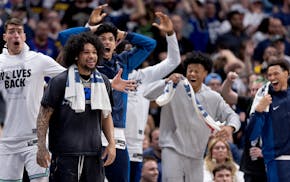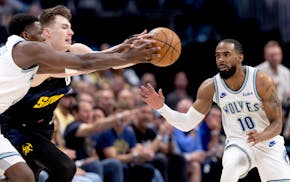When he takes a free throw, Anthony Edwards takes a small step forward as the ball meets the basket. He's not trying to get a leg (or a foot) up on trying to get the rebound in case of a miss. He also isn't off balance. This step is by design, something he and his longtime skills trainer and coach Kierre Jordan have put in Edwards' routine.
The step is because the Timberwolves' All-Star guard begins the shot in his toes to generate power, along with raising his calves.
"A lot of times he would stay on the line and take his shoulders back instead of making sure his momentum was going forward," Jordan said. "So now to make sure we have your momentum going forward, let's add that step after you shoot."
The step has worked. Edwards' free-throw percentage rose to 83.6% from 75.6% a season ago even as his attempts went up from 5.3 to 6.4 per game. He was also on pace to up his three-point percentage numbers this season before a late-season slump took it from 37.3% to 35.7% in the past 10 games. He has made up for that in the playoffs by shooting 41.9%.
And Edwards' all-around scoring ability has been the talk of the league as the Timberwolves swept their first six playoff games heading into Friday's Game 3 of the Western Conference semifinals against Denver at Target Center.
Before Edwards came into the league, one of the knocks on his NBA future was that he would never develop into an efficient shooter, and if there was any criticism Edwards took to heart in his four-year NBA career, it was that one.
Shortly after last season's first-round exit to Denver, Edwards said this in an interview with the Star Tribune: "I'm a scorer. I don't pride my game on just getting to the rim. I hate when people say that. I work too hard to be somebody who finishes at the rim. I can score the ball with the best of them."
About a year after he said that, Edwards is showing the NBA world just how good a scorer he can be — and how good of a shooter he can be. He's averaging 32.3 points per game in the postseason and had three consecutive 35-plus point games, something only replicated at 22 years old or younger by Lew Alcindor (now Kareem Abdul-Jabbar), Kobe Bryant and LeBron James.
"A lot of work, man. It's a lot of work," Edwards said after a 43-point performance in Game 1. "Super tiring. But it's all worth it when it shows on nights like [Game 1]."
Putting in the work
When Jordan, who has worked with Edwards since he was about 15, was asked how often Edwards was working on his mid-range shot this summer, he let out a high-pitched "Oooh." Edwards had four workouts a day over the summer (not all focused on shooting) but he would still put up hundreds of shots per day, to the point he was shooting 2,000 shots per week.
His shot has changed from the time he came into the league. Jordan and Chris Hines, Edwards' player development coach on the Wolves, constantly work with Edwards to make sure his shooting "pocket" is in line — that the process of Edwards bringing the ball up from near his waist to the follow through is clean. That includes having his elbow at the correct 90 degree angle when he brings the ball up and finishing his shot by extending his follow through to the point where his elbow above his eye, instead of finishing in a downward motion.
"From his pocket to his form, it has to stay the same," Hines said.
The challenge is to make that consistent, even when Edwards is doing something besides an open catch-and-shoot three, like shooting a contested midrange jumper. Jordan said the dribble before he shoots is crucial, that the dribble must end up in Edwards' shot pocket so he can get into the normal mechanics of his shot.
"You don't want there to be any type of in-between space where the defender can reach in there and steal the ball, or they can affect your pickup," Jordan said. "So a lot of times we'd make sure it's a lot of hard pound, low to the ground, one dribble pull up."
Not only did Edwards want to work on his midrange game last offseason he also wanted to work on his post-up game. For that, Jordan applied some of the lessons he had from another client of his, New Orleans forward Brandon Ingram.
"That was his favorite thing," Jordan said. "The post-up stuff, I was able to transition the work I use with him and apply it with Ant. Ant, with him being a physical specimen, this is perfect."
In particular, Jordan told Edwards he had to give his defender a "bump" to create separation with his arm or shoulder. Not a bump "chicken wing" style, Jordan said, where Edwards might commit an offensive foul, but more subtle. All that work paid off in a key moment in Game 1, when Edwards had backed down Denver guard Kentavious Caldwell-Pope. There was the bump, and Edwards then whirled around to his right and drained a jumper to put the Wolves up 102-91 with 1 minute, 36 seconds left.
"He would just say, 'I can be the best guard in the league,' " Jordan said. "He was saying that two summers ago. So to be manifesting right now — he had a plan, he had a goal."
Helpful reminders
While Edwards works with Jordan a lot in the offseason, he is working with Hines during the season. Hines, who sits just behind the bench, helps Edwards break down film and is a constant reminder in his ear about his shot mechanics.
"We have all these techniques or sayings that he knows, 'OK, why am I missing that shot?'" Hines said.
He and Edwards have quick ways to communicate that in game. For instance, Edwards knows exactly what Hines means when he says "box" or "you're not in your box."
"That means he's going left or right on his landing," Hines said. "He's not going straight up and down and now he's off-balance in his shot.
A quick "pocket" from Hines to Edwards lets Edwards know he has to fix that process of getting the ball up and released in a straight up-and-down motion with no vacillation.
"Base" means Hines doesn't see Edwards generating power from his legs enough. "Elbow over eyebrow" means Edwards isn't following through properly.
"Now he knows how to change it or fix it in the game," Hines said.
There are times during the long slog of the season that Hines said Edwards could get bored with the repetition, and Edwards would try some different things with his shot, much to Hines' chagrin.
"He can be an elite shooter," Hines said. "He likes playing with it a little bit. It's funny because I'm like 'Dude, just stay solid all the time.' He'll say 'I thought it was gonna go in.' You gotta stop thinking it's going to go in. Make it go in."
Putting it all together
But one area where Edwards hasn't gotten bored is in trying to figure out how teams are guarding him. That's perhaps Edwards' biggest area of growth the second half of the season. When Karl-Anthony Towns went out and teams became even more focused on Edwards, he had to make the right reads and decisions to move off the ball. The lessons he learned then are paying dividends with Towns back in the playoffs.
"It's crazy. It's like a supercomputer," Hines said. "... He's starting to see it at a faster rate. It's going to get to the point where we won't even have to talk about it, it'll just be a read."
Edwards is also trusting that he can get the ball back should he give it up in those situations, and when he does, he's never been more shot ready than he is now, whether from deep, midrange or the free-throw line.
"When I came into the league, the thing was that I couldn't shoot," Edwards said. "So those summers that I had leading up to now, me, C. Hines and Key, it was a lot of work. Just shooting. Just shooting."

Wolves stun Nuggets in Game 7 with comeback for the ages

Read the Game 7 recap: Wolves come back to KO defending champions

With Barkley howling, TNT crew unanimously picks Wolves to win West





